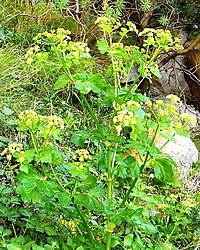Smyrnium olusatrum
| Smyrnium olusatrum subsp. var. | Alexanders, Black lovage, Horse parsley | |||||||||||||||||||||||||||||||||||||||||||||||||||||||
|---|---|---|---|---|---|---|---|---|---|---|---|---|---|---|---|---|---|---|---|---|---|---|---|---|---|---|---|---|---|---|---|---|---|---|---|---|---|---|---|---|---|---|---|---|---|---|---|---|---|---|---|---|---|---|---|---|

|
|
| ||||||||||||||||||||||||||||||||||||||||||||||||||||||
| ||||||||||||||||||||||||||||||||||||||||||||||||||||||||
Alexanders is a commonly cultivated flowering plant, Smyrnium olusatrum, belonging to the family Umbelliferae. It is also known as Alisanders, Horse Parsley and Smyrnium.
Alexanders is native to Europe, western Asia and North Africa. The flowers of this plant are yellow-green in colour and its fruits are black. It has some similarity to celery in the way it looks and in how it tastes. It was once used in many dishes, but it has now been replaced by celery. It was also used as a medicinal herb. In the correct conditions Alexanders will grow up to four or five feet.
| Standard Cyclopedia of Horticulture |
|---|
|
Alexanders. Name applied to Smyrnium Olusatrum (Umbelliferae), the blanched leaf-stalks of which were once used as a salad and pot-herb, but now out of cultivation because of the superior value of celery. It is a biennial, native to Europe, with ternately dissected pinnate radical leaves, and small yellow flowers in umbels. Seed is sown in late summer or in autumn, and the plants transplanted in rows as they come up in spring. The plants are blanched by being banked with earth. CH
|
Cultivation
Propagation
Pests and diseases
Varieties
Gallery
References
External links
- w:Smyrnium olusatrum. Some of the material on this page may be from Wikipedia, under the Creative Commons license.
- Smyrnium olusatrum QR Code (Size 50, 100, 200, 500)
